|
|
|
LIRR TENDERS FOR CLASS G5s LOCOMOTIVES
(Data and Photos Courtesy of Ron Zinn)
|
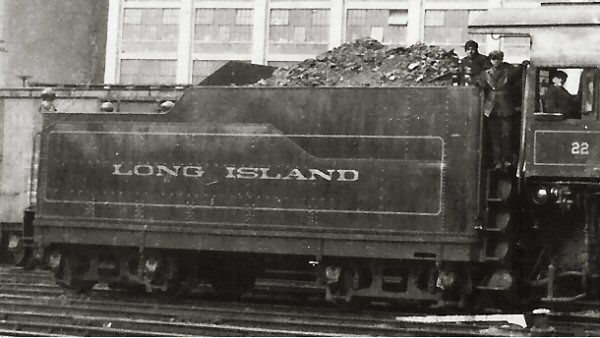 The first four LI G5s' 20-23 delivered in 1924,
came with these tenders, class 70P82. The first four LI G5s' 20-23 delivered in 1924,
came with these tenders, class 70P82.
|
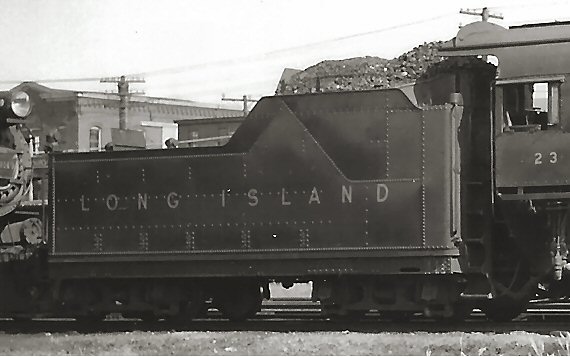 The next five G5s' 24-28 delivered in 1925, came
with these tenders, class 70P82a. These tenders remained in service with
various G5's throughout most of the steam era on Long Island. The next five G5s' 24-28 delivered in 1925, came
with these tenders, class 70P82a. These tenders remained in service with
various G5's throughout most of the steam era on Long Island.
Note: Futura lettering style used briefly
on locomotive tenders in 1940-41 in this photo left.
Research: Dave Keller
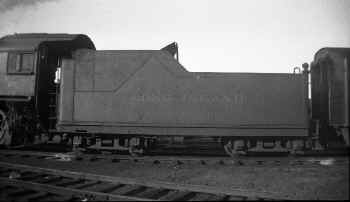
LIRR tender Class: 70.P.82a behind
G5s #25 at Oyster Bay 1940 with Penn Roman
style lettering. (T. Sommer-Keller) Research: Dave Kelller
|
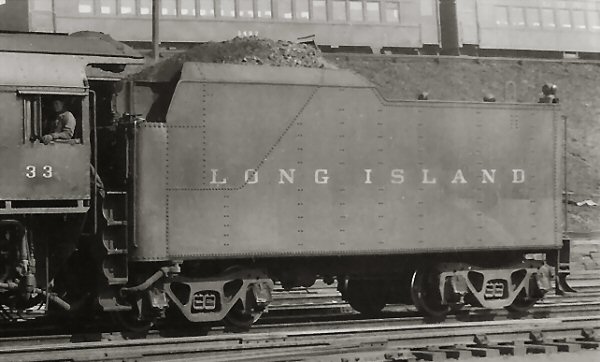 The next ten G5s' 29-38 delivered in 1928, came
with these tenders, class 110P82a. These
tenders were specifically designed by William Kiesel of the Pennsy for the
Long Island G5's. They were
designed for hand firing and no Pennsy G5's ever had them. The next ten G5s' 29-38 delivered in 1928, came
with these tenders, class 110P82a. These
tenders were specifically designed by William Kiesel of the Pennsy for the
Long Island G5's. They were
designed for hand firing and no Pennsy G5's ever had them.
In addition, four of these tenders had been built
by Baldwin Locomotive Works to Kiesel's drawings in 1926 for the Long
Island Rail Road. The only
difference between those four and the ten 1928 tenders was the number of
internal braces.
Those four tenders replaced the four 70P82
tenders delivered in 1924 with the first four G5's. The 70P82 tenders were then coupled to camelbacks.
Info: Ron Zinn
Note: This would explain why
the Sunrise Special images all showed G5s #21 pulling this type tender c.
1927, as #21 was one of the first four G5's delivered in 1924. Info: Dave
Keller
|
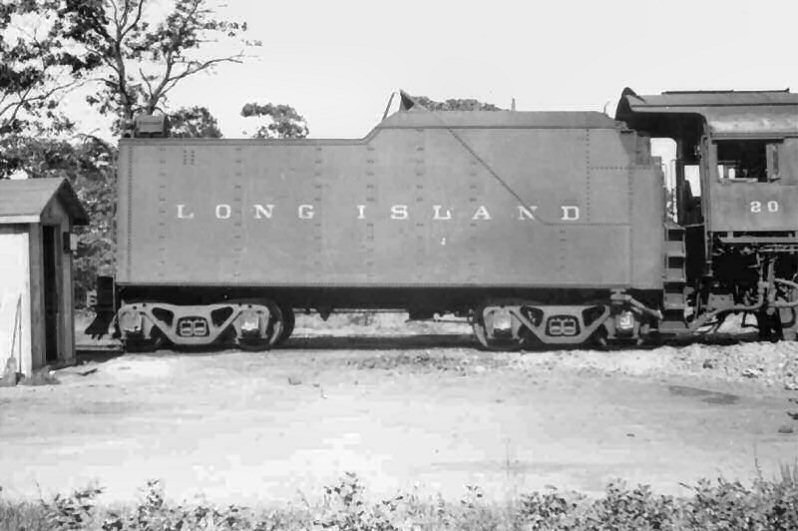 G5s
#20 delivered in 1924,
came with tender, class 70P82. Here shown with replacement tender class
110P82a. The locomotive and tender laying up at the end of the wye
at Ronkonkoma, view looking east. The shanty at the left was later
replaced by the former "KO" cabin structure when the cabin's use
was discontinued (1934) and the block office moved into the ticket office.
Structure remained trackside until sometime in the 1940s when it was moved
to the end of the wye.
G5s
#20 delivered in 1924,
came with tender, class 70P82. Here shown with replacement tender class
110P82a. The locomotive and tender laying up at the end of the wye
at Ronkonkoma, view looking east. The shanty at the left was later
replaced by the former "KO" cabin structure when the cabin's use
was discontinued (1934) and the block office moved into the ticket office.
Structure remained trackside until sometime in the 1940s when it was moved
to the end of the wye.
Pin striping was removed by 1932 and the
lettering is spaced farther apart (applied 1942) than when originally
delivered. Photo is c.1946 Research: Dave Keller
|
|
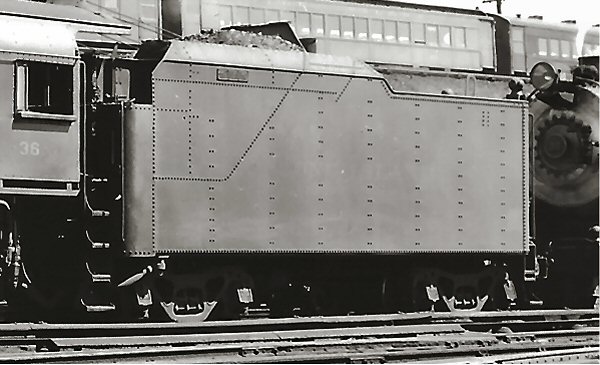 The last twelve G5s' 39-50, delivered in 1929-30,
came with these tenders, also class 110P82a. You can see the difference between these and the previous 110P82a
tenders. Notice the line of
rivets near the top below the equipment trust plate and the longer collar
at the top of the coal space. This
is because these twelve tenders were originally designed for Pennsy M1
mountain type engines.
The last twelve G5s' 39-50, delivered in 1929-30,
came with these tenders, also class 110P82a. You can see the difference between these and the previous 110P82a
tenders. Notice the line of
rivets near the top below the equipment trust plate and the longer collar
at the top of the coal space. This
is because these twelve tenders were originally designed for Pennsy M1
mountain type engines.
In 1929 the Pennsy had these tenders converted
and sold them to the Long Island for use on the final twelve G5's. The conversion involved removing the inner sloped sides of the coal
space. These were originally
sloped because these tenders were built for stoker firing, hence the line
of rivets at the top. The coal
space was shortened, a 45 degree slope sheet put in and the deck height
was raised to match the G5 firing deck.
The Pennsy had started building
long distance tenders for the M1's, making these tenders available for the
Long Island.
|
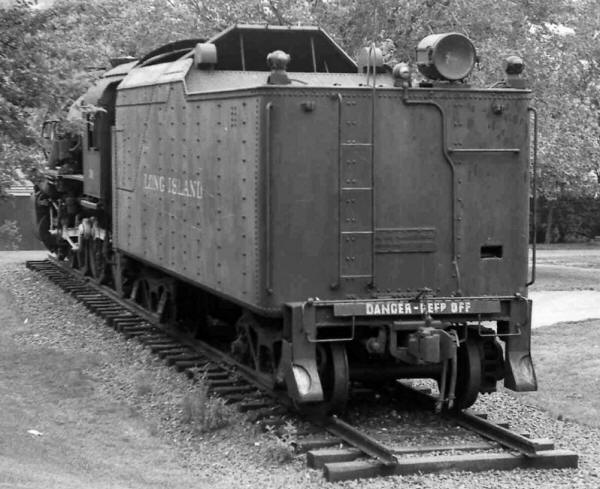 |
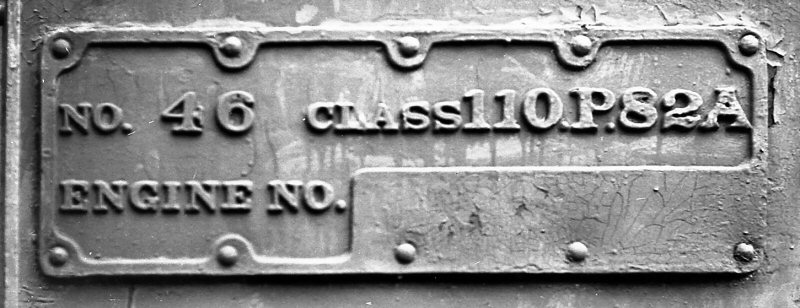
LIRR G5s #39 - Tender Class 110P82a #46 Builder
Plate - Carriage House, Stony Brook
c. 1966 Photos/Archive: Richard Glueck
|
|
LIRR TENDERS FOR CLASS H10s LOCOMOTIVES
(Data and Photos Courtesy of Ron
Zinn)
|
"Lines West" Tenders on H10s Locomotives:
All nineteen H10s locomotives that came to the LIRR from the Pennsy were "Lines West" engines. They all carried high numbers on the Pennsy as did all "Lines West" engines: in the 7000-8000 range. The smaller tenders that some of the
pre-stokered engines hauled were also "Lines West." (Data courtesy of Ron
Zinn)
|
|
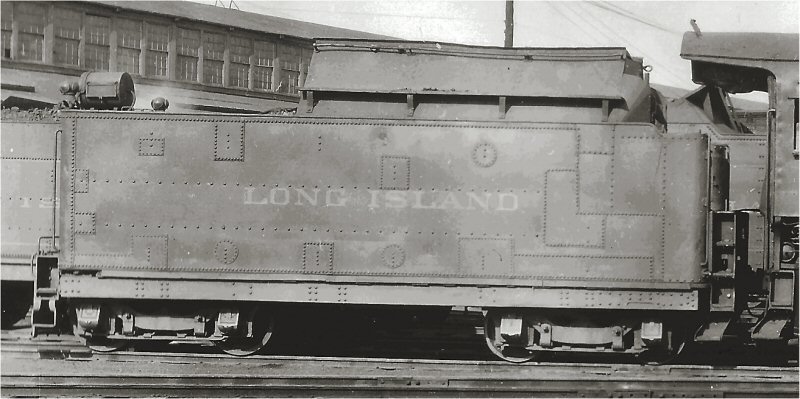 When
the H-10's arrived on Long Island in 1928-29, they came from PRR Lines
West. Some of them were equipped with these tenders which were set
up for hand firing. This particular tender had a classification
plate which indicated that it was class 80P79. Some Pennsy Lines West K3 passenger engines were
equipped with this type of tender which probably accounts for the 80P79 passenger tender classification. When
the H-10's arrived on Long Island in 1928-29, they came from PRR Lines
West. Some of them were equipped with these tenders which were set
up for hand firing. This particular tender had a classification
plate which indicated that it was class 80P79. Some Pennsy Lines West K3 passenger engines were
equipped with this type of tender which probably accounts for the 80P79 passenger tender classification.
|
|
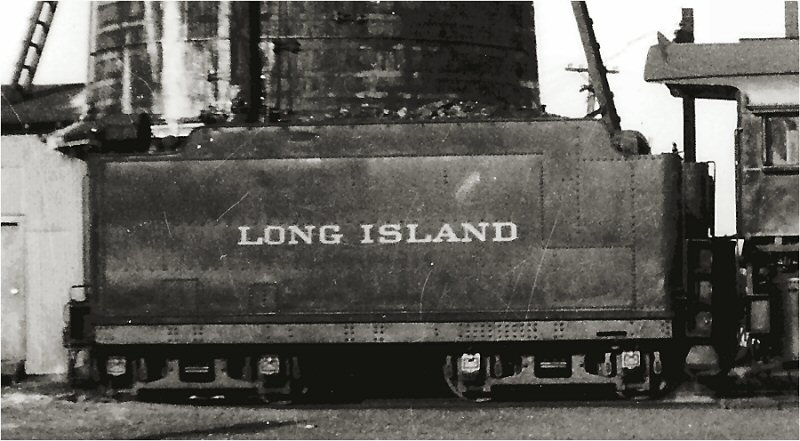 Some
of the H-10's were equipped with these tenders which were also a Lines West
design. I'm not sure, but these tenders may have been class 70F66e. These
were also set up for hand firing. Some
of the H-10's were equipped with these tenders which were also a Lines West
design. I'm not sure, but these tenders may have been class 70F66e. These
were also set up for hand firing.
|
|
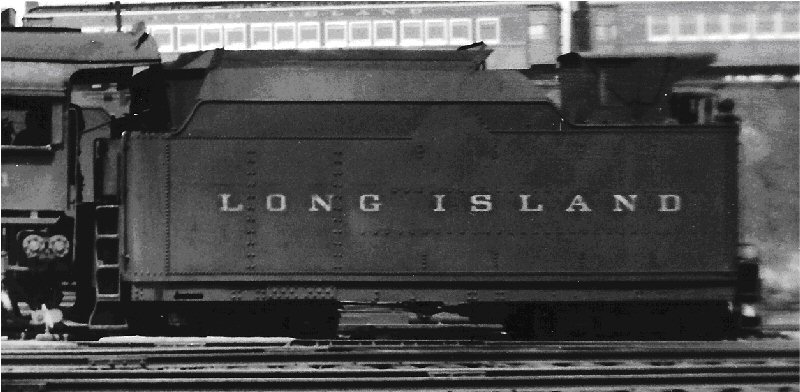 When
the Long Island H-10's were equipped with stokers in 1945-46, they received
these tenders which were class 80F81a. As you can see this tender has
a brakeman's doghouse. When
the Long Island H-10's were equipped with stokers in 1945-46, they received
these tenders which were class 80F81a. As you can see this tender has
a brakeman's doghouse.
The first H-10 to be stokered may
have been the 105 in June of 1945. The 113 was still hand fired as
late as 1947. None of these tenders had brakeman's doghouses when they
first appeared on the LIRR. This photo dates from 1949 so I would say
that these doghouses, as they were called, were added during the late
1940's. I can't say which engines had them because tenders were always
being switched around. Photographic evidence would seem to indicate
that most, if not all of these tenders received brakeman's doghouses. Stokering had nothing to do with the addition of the "doghouses."
Apparently it was decided that the brakeman's perch was a beneficial
addition.
|
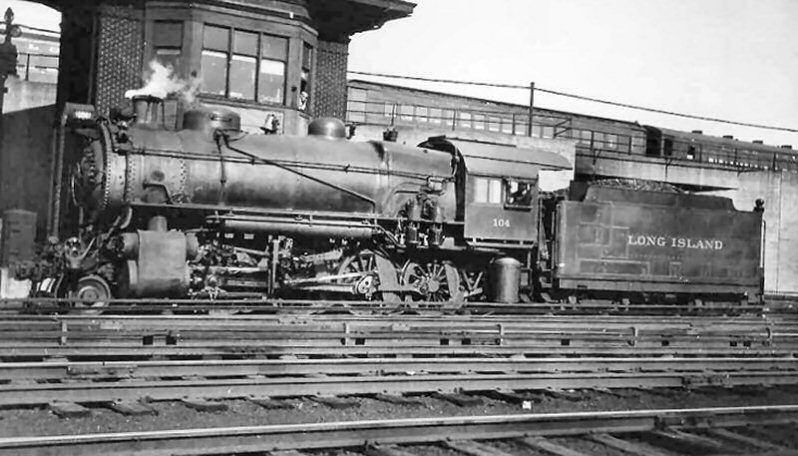 LIRR
#104 H10s (2-8-0) at "DUNTON" tower to receive train orders with tender class 70F66e.
View N - c.1940's. LIRR
#104 H10s (2-8-0) at "DUNTON" tower to receive train orders with tender class 70F66e.
View N - c.1940's.
|
.jpg) H10s
#103 with Brakeman's Shelter "Doghouse" on tender, class 80F81a,
at Holban Yard-Hollis 10/1954 Archive: Dave Keller H10s
#103 with Brakeman's Shelter "Doghouse" on tender, class 80F81a,
at Holban Yard-Hollis 10/1954 Archive: Dave Keller
|
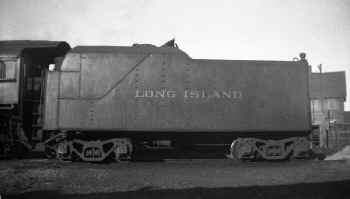
LIRR Tender Class 110.P.82a behind G5s locomotive at Oyster Bay
1940 (T.
Sommer-Keller)
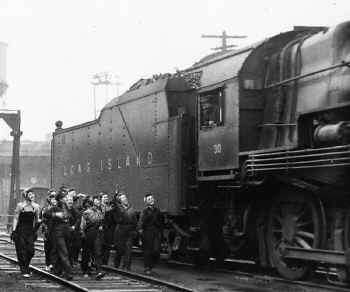
LIRR G5s #30 tender with engine wipers at Morris
Park Shops
10/1942 Archive: Ron Zinn
|
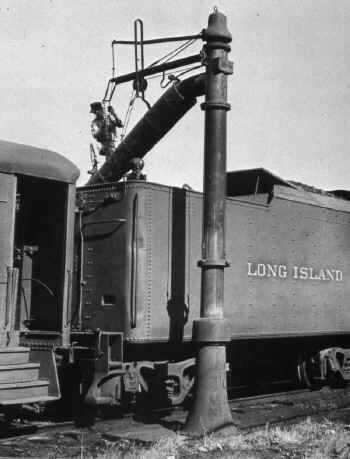
G5s #21 tender taking on water at
Ronkonkoma 8/1947
Archive: Dave Keller
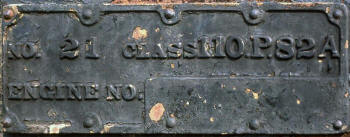
G5s #21 tender Class 110.P.82A builder plate 4/1987
Photo/Archive: William Mangahas
|
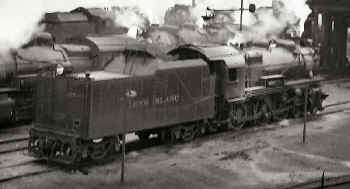
G5s #34 Morris Park Shops c.1935 Footboards
on passenger tender Archive: Ron Zinn
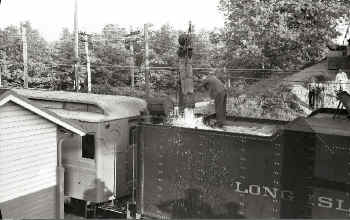
G5s LIRR #39 tender taking on water
Ronkonkoma 6/05/1955
Archive: Dave Keller
|
|
Note: Female engine wipers at Morris
Park Shops having some fun with the hostler, Jim Calisto, of G5s #30 as they head out to
their work assignments. These women temporarily replaced the men who
were drafted into the military for wartime service. Their job was to wipe
off the oil and grease from the locomotives that came into the shops.
The woman in the front left with the
shiny buttons up her front is definitely NOT a trainman or conductor. She's
Rose Penna who was 20 years old at the time. The idea that women were
working in what were traditionally men's jobs was considered newsworthy back
then. Pictures of female engine wipers on the LIRR appeared in various
newspapers and magazines. Rose Penna appeared in many of these photos, some
close-ups in which she was identified in the captions.
She was the one who always wore some
sort of cap and a jacket. The LIRR started hiring women as engine wipers in
September 1942. The women in this photo were among the first to be hired.
The LIRR did hire Female trainmen but probably starting in 1943. According
to Ron Ziel they were called "wheels". Info: Ron Zinn
|
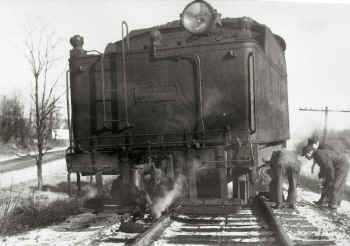
LIRR Tender No. 136 Class: 60.P.80 behind
G53 #144 in derailment near Northport c.1945 Archive:
Dave Keller
|
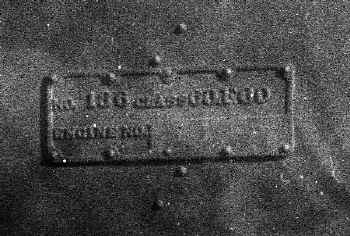
LIRR Tender No. 136 Class: 60.P.80
Close-up of Tender Plate c.1945 Archive: Dave Keller
|

LIRR tender Class: 70.P.82a behind
G5s #25 at Oyster Bay 1940 with Penn Roman
style lettering. (T. Sommer-Keller) Research: Dave Keller
|
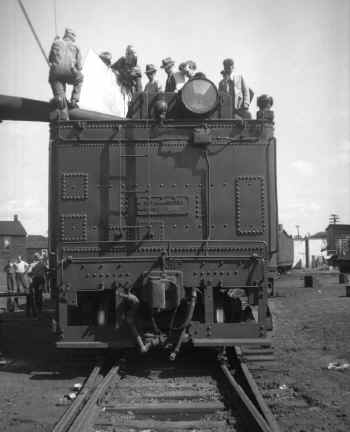
LIRR Tender No.107 Class 80.P.81 taking water behind LIRR H10s #105
during filming of Floyd Gibbons' "True Adventure Stories" at
Oyster Bay 09/06/37. The location represented Wellington, KS on the
AT&SF. AT&SF-style crossing signs were erected in the yard for
additional filming sequences. (Ted Sommer photo - Dave Keller archive
and data)
|
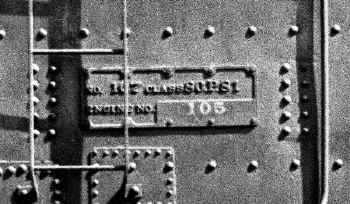
LIRR Tender No. 107, Class 80.P.81 on H10s locomotive #105 per tender plate
- 9/06/37 - Close-up view of image at left. ( T. Sommer photo - Dave Keller
archive)
Class 80.P.81 LIRR passenger tender
Water gallon capacity: 81,000 coal lbs. capy: 34350
Weight empty: 76700 weight loaded: 178550
|
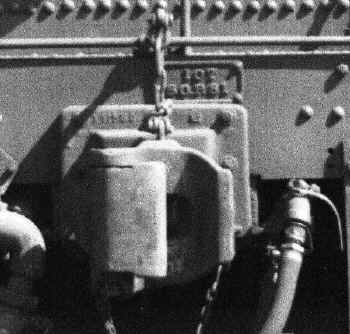
LIRR Tender Class 80.P.81 No. 107 behind
H10s #105 close-up of Tender Plate at coupler
9/06/37
(T. Sommer-Keller)
|
